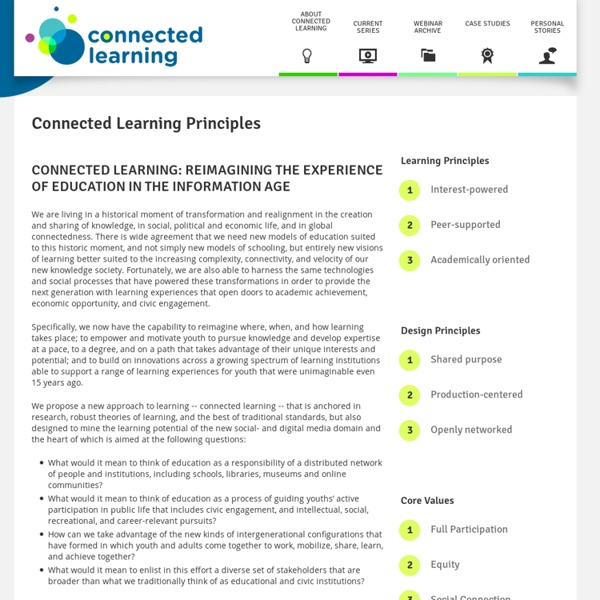Connected Learning Principles
We are living in a historical moment of transformation and realignment in the creation and sharing of knowledge, in social, political and economic life, and in global connectedness. There is wide agreement that we need new models of education suited to this historic moment, and not simply new models of schooling, but entirely new visions of learning better suited to the increasing complexity, connectivity, and velocity of our new knowledge society. Fortunately, we are also able to harness the same technologies and social processes that have powered these transformations in order to provide the next generation with learning experiences that open doors to academic achievement, economic opportunity, and civic engagement. What would it mean to think of education as a responsibility of a distributed network of people and institutions, including schools, libraries, museums and online communities? At the core of connected learning are three values:
quietube | Video without the distractions | Youtube, Viddler, Vimeo and more
Connectivism | Learning in the Future
Overview Connectivism has been developed by George Siemens and Stephen Downes based on their analysis of the limitations of traditional learning theories to explain the effect technology has had on how we live, how we communicate, and how we learn.[1] According to co-developer Stephen Downes (2007), connectivism posits that “knowledge is distributed across a network of connections, and therefore that learning consists of the ability to construct and traverse those networks.[2]” As with constructivism and active learning, connectivism theorizes that knowledge is not acquired, as though it were a thing. Knowledge is the set of connections formed by actions and experience. In connectivism, there is no real concept of transferring knowledge, making knowledge, or building knowledge. Networked learning and connectivism Networked learning is a subset of connectivism, which consists of eight attributes [3]: Principle 1: Learning and knowledge rests in diversity of opinions. Resources References
Promethean Planet - Activtips by Promethean, Inc.
A Day in the Life of a Connected Educator – Using social media in 21st century classrooms
One of our main goals at Powerful Learning Practice is to turn educators into 21st Century educators. That is, teach them how to use social media and other powerful Web 2.0 tools to transform their classrooms into learning environments that are ready for today’s iGeneration students. One of the most common questions we get is, “But where do we find the time to use all this new technology?” To answer that question, we developed this infographic – A Day in the Life of a Connected Educator to show that using social media in your classroom and in your life can be integrated, easy, and fun. Scroll down and take a look or click for a larger version. Get connected Would you like to become a connected educator? Explore more about the life of a Connected Educator and 21st Century teacher & learner in The Connected Educator: Learning and Leading in a Digital Age by Sheryl Nussbaum-Beach and Lani Ritter Hall. Tweet all about it What does a typical day in a 21st century classroom look like?
Gamestar Mechanic
How to Learn on Your Own: Creating an Independent Scholar Resource Plan
One of the most challenging and gratifying parts of learning alone is the opportunity to search for and select your own learning material. Students in traditional classrooms usually don’t get to decide how they are going to master course content. Instructors decide for them in the form of textbook selection, quizzes, tests, group projects, etc. As an independent learner, you can make your study time more effective by using only the learning methods that work for you. A resource plan is a document used to brainstorm the learning material you can use when you begin your studies. This article will show you how to create a resource plan to use in your independent studies. Step 1: Set a Goal The first step to creating a resource plan is to decide on a single goal. Ineffective Goal – Learn HTMLEffective Goal – Create several websites using HTML, referring only minimally to a coding book. Step 2: Collect Materials Books – The written word is still one of the best ways to learn a subject.
Three Ways Game-Based Learning can be a Helpful Tool
“A game is an opportunity to focus our energy, with relentless optimism, at something we’re good at (or getting better at) and enjoy. In other words, gameplay is the direct emotional opposite of depression.” Jane McGonigal, Reality is Broken: Why Games Make Us Better and How They Can Change the World Game-based learning is fast becoming a trend in education. Games as Assessment: As students play games they are being assessed on their progress, provided feedback, and allowed to try again without fear of failure. Games as Engagement: Games are carefully and intentionally designed environments that create flow—the balance between challenge and progress. Authentic Learning Experiences: James Paul Gee, game-based learning advocate and guru refers to this as “situated learning.” Games can be another tool for engaging in rigorous and authentic learning.
Learning by doing
wiki
ExitTicket | Student Response System | Student Clickers | Exit Tickets | Classroom Response System
Related:
Related:



